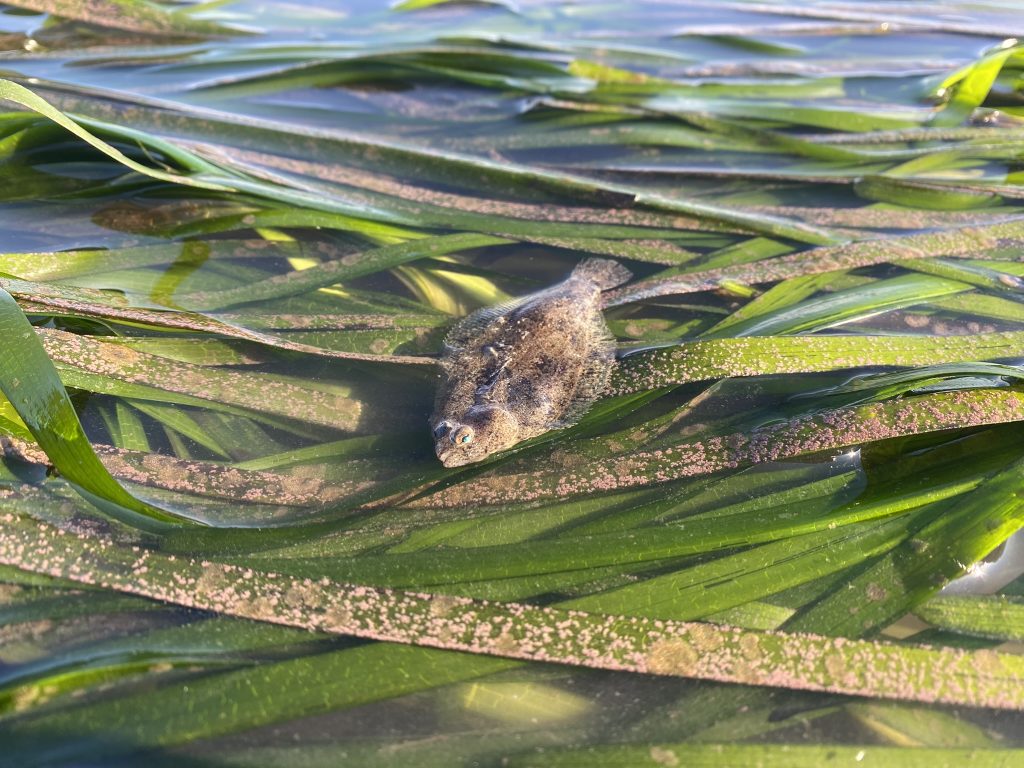Highlight photo courtesy of Lisa Needles, 2021.
Over the past two decades, climate change has altered the range and distribution of many species, leading to ecosystem shifts. These shifts can affect how we manage, plan, and prioritize conservation efforts. Advanced techniques like environmental DNA, or eDNA, can offer a quick and accessible approach to detecting species shifts. The Estuary Program has been involved in several eDNA projects over the past few years, including recent support for the Pacific eDNA Coastal Observatory (PECO) project.
What is PECO?
PECO is an inter-organizational partnership that uses eDNA to better understand fish biodiversity within coastal seagrass beds. PECO was piloted in 2021 by the Hakai Institute in collaboration with the Sunday Lab at McGill University. The PECO project is endorsed by the UN Decade of Ocean Science and Sustainability and is part of the Ocean Biomolecular Observation Network (OBON), an international initiative promoting community-based eDNA monitoring efforts.

PECO relies on a diverse collaboration of nonprofits, state and federal agencies, tribes, and universities ranging from the Gulf of Alaska to San Diego. By ensuring broad geographic coverage, this network captures a variety of latitudes and environmental conditions. The Estuary Program has supported the PECO effort for the past two years and recently completed our summer sampling in Morro Bay.
The map above shows the PECO sampling sites across the west coast. Map provided by PECO via peco-project.weebly.com.
What Is eDNA?
Environmental DNA, or eDNA, refers to the genetic material that organisms naturally shed into their environment through skin, scales, mucus, waste, or other biological processes. This DNA can be collected from various sources, including water, soil, or even air.

The PECO monitoring process involves collecting water samples using sterile techniques and then running them through an extremely fine mesh filter to capture small fragments of DNA left behind by organisms. The filter is then preserved and analyzed using a process called eDNA metabarcoding, which helps to determine which species were present in the water sample.

What Can it Tell Us?
While eDNA monitoring is still a relatively new tool, it offers several unique advantages. Traditional fish sampling techniques typically involve using boats, nets, and traps to capture fish which then need to be counted, identified, and measured by hand. This can be time-consuming and labor-intensive, and usually requires special permitting, skills, and expertise. While these traditional approaches can provide us with detailed information like count, appearance, length, and weight, they may miss species that are difficult to capture, especially in complex habitats like eelgrass beds.
Using eDNA analysis, we can detect multiple species simultaneously including those that are rare, difficult to capture, or even nocturnal. Analyzing eDNA also takes significantly less time and money than traditional sampling methods, allowing for large-scale monitoring projects like PECO to be possible.

Our Morro Bay Sampling Effort
The Estuary Program recently collected samples for the PECO project at two locations in Morro Bay: Coleman Beach near Morro Rock and Tidelands Park near the boat launch. At each site, we collected four water samples from within eelgrass beds, an essential habitat for many marine species.
The sampling process involved collecting water using sterile techniques, filtering it to concentrate the DNA, and then preserving the filters. Once preserved, the eDNA samples were sent to the Hakai Institute for analysis to identify the presence and diversity of marine fish species. The results are used by PECO in their ongoing assessment of marine biodiversity along the Pacific Coast.

Next Steps
McGill University and the Hakai Institute are working together to analyze data from the first few years of the PECO project. Preliminary results show that many species have their northern or southern range limits within the study area. Initial trends also suggest changes in species distribution around the southern California Bight and Point Conception regions.
In the coming years, PECO will continue to analyze fish communities across different latitudes and environmental conditions. The project will also compare results with global databases to better understand broader implications and uses for the data.

For more information about PECO and project partners, please visit https://peco-project.weebly.com/.
Help us protect and restore the Morro Bay estuary!
- Donate to the Estuary Program today and support our work in the field, the lab, and beyond.
The Estuary Program is a 501(c)3 nonprofit. We depend on funding from grants and generous donors to continue our work. - Support us by purchasing estuary-themed gear from ESTERO. This locally owned and operated company donates 20% of proceeds from its Estuary clothing line and 100% of Estuary decal proceeds to the Estuary Program. Thank you, ESTERO!
- Purchase items from the Estuary Program’s store on Zazzle. Zazzle prints and ships your items, and the Estuary Program receives 10% of the proceeds.
- Subscribe to our seasonal newsletter: Between the Tides!
- We want to hear from you! Please take a few minutes to fill out this short survey about what type of events you’d like to see from the Estuary Program. We appreciate your input!